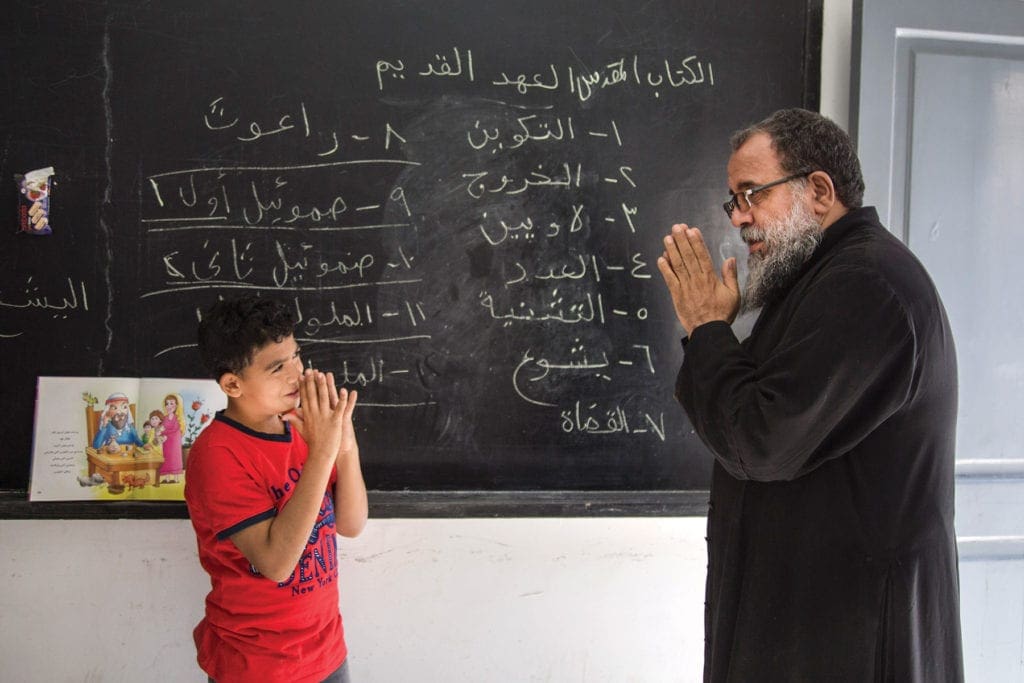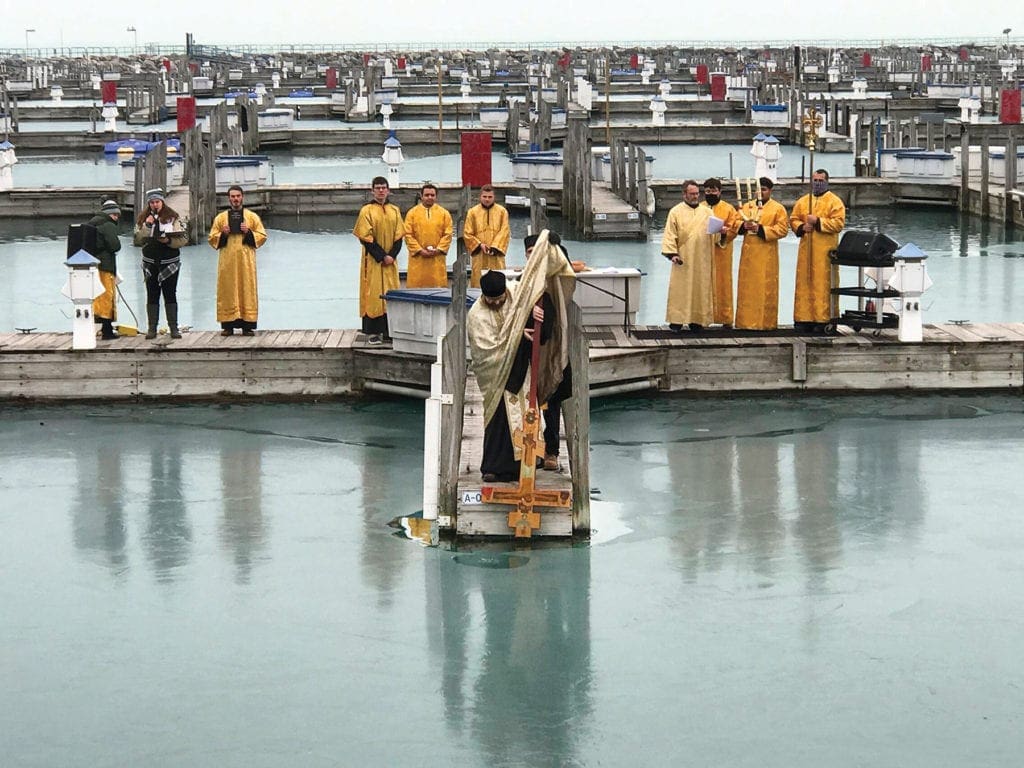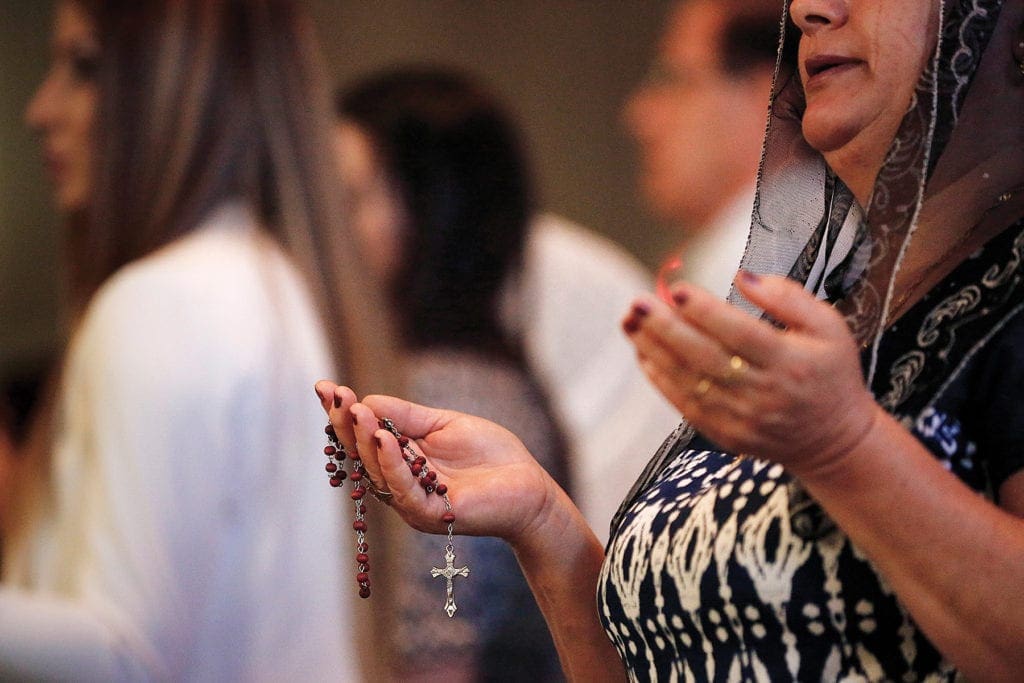Editors’ note: For 95 years, CNEWA has worked hand in hand with the Eastern churches, Catholic and Orthodox, in their native lands and cultures. Part of CNEWA’s mission is to educate Catholics in the West about their sister churches in the East. To accomplish this mission, CNEWA is initiating a series, entitled “People, Look East.” In this opening piece, we will treat the notion of a church sui juris and the salvific role of these churches within the universal church.
Ten years ago, in January 2011, the Middle East changed unexpectedly, suddenly and perhaps forever. Just months prior, in October, the Holy See held a Special Assembly for the Middle East of the Synod of Bishops to address the difficulties facing Christians there. For synod members, the Middle East was a challenging place. However, at the time it was a relatively known and stable, if fragile, entity.
Less than three months later, the so-called Arab Spring had begun, sparked by the death of Tunisian street vendor Mohamad Bouazizi, who had set himself on fire in protest of having been abused by Tunisian authorities. Anti-government demonstrations erupted all over the Middle East. Within six months three national governments had fallen and a civil war had begun in Syria. In this context the Islamic State in Syria (ISIS) emerged. It proclaimed itself to be the Islamic Caliphate in June 2014, with Abu Bakr al-Baghdadi as its caliph. A persecution was unleashed against Christians and other religious minorities, the likes of which has not be seen since the Mongol invasion of the 13th century.
This attack on Christians catapulted some ancient yet little-known churches into the headlines and into the Western consciousness. Many Latin-rite Catholics heard for the first time about the Eastern Christian communities, including the Assyrian Church of the East, the Armenian, Chaldean, Maronite, Melkite, and Syriac Catholic and Orthodox churches.
In addition to the increased media attention on these persecuted Christians, the subsequent huge migration of peoples brought an entirely new level of awareness. Latin-rite Catholics in Western Europe, North and South America and Australia suddenly had Christian neighbors in large number who were quite different. Their new neighbors had different customs, celebrated the sacraments differently — and many were quite insistent of their Catholic identity. In addition, Latin-rite Catholics were almost totally unprepared for the wives and children of the married Eastern Catholic priests, who came to minister to these newly arrived faithful.

Both before and after this recent migration, the Eastern churches have often been regarded in one of two ways: either as treasure houses of exotic art, liturgy and customs, or in terms of their relationship to the bishop of Rome, the pope. Worse yet, Eastern Christians in the United States in the 19th century — most of them from Central or Eastern Europe and members of the various churches of the Byzantine tradition — were looked upon at times with downright suspicion and hostility.
While there may be some justification for these two tendencies, both fail to recognize these churches as living, active agents of evangelization. These churches have salvific value and continue to be instruments of Christ in the world. Furthermore, while their relationship to the bishop of Rome is significant, to focus exclusively on this aspect is reductionist and, hence, theologically inadequate.
Although most Roman Catholics are only peripherally aware of it, the universal Catholic Church comprises 24 churches — one of which, the largest, is the Roman Catholic Church. The other 23 are self-governing Eastern churches, defined as “sui juris,” meaning “of one’s own right.” This Latin juridical term is used in both civil and canon law to describe a person who is not under any legal disability or subject to the authority of another person. They are fully capable of managing their own affairs and can act on their own behalf.
While “sui juris” is in no way a biblical term, these little-known juridical entities have exceedingly important theological significance. Their existence and flourishing also have crucial implications for the universal church and its credibility as an authentic witness as the Body of Christ. In sum, these churches are a legitimate and authentic response to the resurrection and mission of Christ in ways that have yet to be recognized fully and appreciated in the West, although worthy attempts have been made.

Multiple documents of the Holy See, published between 1894 and 2012, have played a major role in helping Catholics understand the Eastern churches. Three will be highlighted here. In this 116-year period, several important events occurred both within the Catholic Church and in the world to impact directly and indirectly the understanding and appreciation of the Eastern Catholic churches.
In the 20th century, the church saw a significant development in its ecclesiology, expressed in the dogmatic and pastoral constitutions of the Second Vatican Council — “Lumen Gentium” (1964) and “Gaudium et Spes” (1965) respectively. “Lumen Gentium” describes the church primarily, though not exclusively, as “a people brought into unity from the unity of the Father, the Son, and the Holy Spirit.” The church is the people of God on pilgrimage to fulfillment in God. The biblical and charismatic aspects of the church, previously less emphasized, were put on a level with the juridical. While the council did not deny by any means that the church is a juridical entity, it did insist that it was not primarily juridical.
Relations with the Eastern Catholic churches previously were also heavily weighted with juridical concepts and language. In the document of the Holy See on the Eastern Catholic churches, “Orientalium Dignitas” (1894), Pope Leo XIII states that the Roman church “rejoices in (the Eastern churches’) faithful obedience.” A sign of the catholicity of the church, he writes, is “the sight of differing forms of ceremonies and noble examples of the tongues of the ancient past … rendering their submission to the church.”
Along with these mentions of “obedience” and “submission,” Leo is genuinely concerned about protecting the “integrity proper to the discipline of the Eastern churches” and removing “reasons for rivalry and suspicion.” A great deal of the letter details how the integrity of the Eastern Catholic churches is to be protected against encroachments from overzealous clergy of the Latin rite.
Attacks on Middle East Christians catapulted some ancient yet little-known churches into the headlines and into the Western consciousness.
With Vatican II, the Catholic Church enters into dialogue with those Eastern churches not in full communion with it, known as the Orthodox churches, and an interesting evolution takes place in these documents. The respect that the ecumenical dialogue among the churches at this time engendered could not but influence the attitude toward the Eastern Catholic churches, expressed in the very important conciliar decree on the Eastern Catholic churches, “Orientalium Ecclesiarum” (1964).
At the outset, the decree declares: “The Holy Catholic Church … is made up of the faithful who are organically united in the Holy Spirit by the same faith, the same sacrament, and the same government, who, combining together into various groups which are held together by a hierarchy, form separate churches or rites.”
It states that these churches are “of equal dignity, so that none of them is superior to the others as regards rite and they enjoy the same rights and are under the same obligations.” This description of the Eastern Catholic churches as being of “equal dignity” is extremely significant and marks a major shift away from the notions of “obedience” and “submission” put forth by Pope Leo XIII.
However, reading the decree almost 60 years later, there is a noticeable awkwardness in the text. Since the Eastern Catholic churches are full and equal members of the Catholic Church, Vatican II was as much an ecumenical council of these churches as of the Roman Catholic Church. Yet, throughout the decree, the Eastern Catholic churches are referred to in the third person. If the Eastern Catholic churches in the decree are “they/them,” a question arises: Who are the “we/us” of the decree? Nevertheless, “Orientalium Ecclesiarum” is in many ways, a “bridge” document, encouraging the churches to move on to new and deeper levels of appreciation and respect.

Movements in the world at large also influenced the universal church in its response to the challenge Pope John XXIII had presented at the start of the council: to “read the signs of the times.” The 20th century saw the dismantling and discrediting of imperialism and colonialism. Once the accepted modus operandi of the times — between the rich and the poor, the powerful and the weak — was rejected, attempts were made to install more just political systems in the world.
At the same time, great strides were made in recognizing the rights and values of indigenous peoples and minorities. While these movements may not have impacted the church’s ecclesiology directly, they effected a change of atmosphere — in the church and globally — that discouraged arrogance, unilateralism and triumphalism, and encouraged greater respect for the other.
In this atmosphere, it was both essential and desirable for the church to go beyond the juridical sui juris status of these minority Eastern Catholic churches, to acknowledge their history and to recognize their role in the mission of salvation as inspired and authentic “incarnations” of the Gospel message within the multitude of cultures throughout the world.
After the Resurrection, Christianity moved beyond the Roman province of Judea. Already at the crossroads between Europe, Asia and Africa, the followers of Jesus spread to all three continents within a generation of the first Easter. Communities of believers — whether Jewish, Gentile or mixed — began to appear in the major cities of the Roman Empire and of the Parthian Empire (247 B.C.-224 A.D.), which extended to China in the east.
“Culture is not something superficial, something ‘added on’ to what is essential. It is a central and incarnational part of Christianity.”
Each of these faith communities arose in a particular place, time, language and culture, forming local churches. Their formation epitomized the “incarnation” central to the Christian faith that Pope John Paul II speaks about in his apostolic letter on the Eastern churches, “Orientale Lumen” (1995). The eternal Word of God became incarnate in a concrete and specific time and place — Second Temple, Roman-occupied Palestine — in a specific culture — Second Temple Judaism, possibly Pharisaism — speaking a specific Semitic language — Hebrew or an Aramaic dialect — along with everything that this historical and cultural context entailed. In other words, “like us in all things but sin” (cf. Heb 4:15).
Analogously, after the Resurrection, the Christian faith became “incarnate” in different yet specific and concrete places, cultures and languages, wherever it struck root. Also analogous to the Incarnation, these local and specific “incarnations” of the faith are not without universal significance and value.
Paul’s letters, in which he addresses the “churches” of Corinth, Rome, Galatia and others, demonstrate clearly how the Christian faith became “incarnate.” In one sense, the geographic marker in Paul’s letters is merely that: the city or province where the church existed. It was clearly not a juridical marker. Nevertheless, one notices in the letters that the churches differ among themselves in many ways. The Corinthian church, for example, tends to be intellectually contentious and susceptible to factions, while rich in charismatic gifts.
As expressed in “Orientale Lumen,” it is clear in the early church that the unity of Christianity was the unity in faith — the communion — that the churches shared with each other, and not uniformity in cultural practice or jurisdiction.

Culture is not something superficial, something “added on” to what is essential. It is a central and incarnational part of Christianity. It colors how we experience, how we believe and how we express that belief. In the words of “Gaudium et Spes”: “In his self-revelation … culminating in the fullness of manifestation in his incarnate Son, God spoke according to the culture proper to each age … [and] the church has utilized the resources of different cultures in its preaching and to spread and explain the message of Christ, to examine and understand it more deeply, and to express it more perfectly.”
As Christianity grew in disciples and geographic reach, local particularities would strengthen, and differences would become more pronounced. Within a century, certain Christian centers developed, each representing the different cultures of different churches: Jerusalem, Antioch, Alexandria, Rome and later Byzantium (or Constantinople). As centers of Christianity grew, scholars, preachers and saints arose, who helped to articulate the local “incarnation” of the faith. The great theological schools of Antioch in Syria, Alexandria in Egypt, and Nisibis in present-day Turkey are three important examples.
Within this considerable diversity, there was belief in the “one, holy, catholic and apostolic church,” consisting of varied communities of believers. The unity certainly was not juridical and most definitely was not a unity accomplished through the submission of one community or culture to another. There was precedence given to the churches of the “Pentarchy,” the five ancient patriarchates — chronologically, Jerusalem, Antioch, Rome, Alexandria, and Constantinople — but it was a precedence of honor and respect, not of submission.
Therefore, with “Orientale Lumen” in 1995, we see the most recent development in the Catholic Church’s understanding of the role of the Eastern churches. The document begins with the principle that the “ancient tradition of the Eastern churches is an integral part of the heritage of Christ’s church,” and that “the full manifestation of the church’s catholicity…[is] expressed not by a single tradition.”

In other words, the Eastern Catholic churches are not simply “add-ons” to be tolerated; they are critical to the mission and credibility of the universal church. The message of salvation is so rich and vast that it cannot be encapsulated in any one culture or tradition. To restrict the manifestation of the Gospel in this way would make the message of salvation less encompassing, less accurate and incomplete.
Noting that “Eastern Christians have their own way of perceiving and understanding,” John Paul II points out in his apostolic letter how the various Eastern Catholic churches and the Roman Catholic Church complement one another in shedding light on issues of faith: “In the study of revealed truth East and West have used different methods and approaches in understanding and confessing divine things. It is hardly surprising, then, if sometimes one tradition has come nearer to a full appreciation of some aspects of a mystery of revelation than the other or has expressed them better.”
Diversity in the Christian life is not a threat to orthodoxy; it is a help to it, and John Paul II recognizes this in “Orientale Lumen.” Recalling the Great Schism between the Eastern and Western churches in 1054, the pope highlights an important reality even for the present, when he laments that the cause for the rift was “a progressive estrangement, so that the other’s diversity was no longer perceived as a common treasure, but as incompatibility.”
This admission is of great importance. In addition to being a refreshing act of theological modesty, it removes one of the dangers that exists in the relationship between the Western and Eastern churches — quaintness. There is a great danger of reducing Eastern churches to interesting, exotic and archival entities, which, for all their quaintness, are irrelevant from a Western Christian point of view. In a real way, this point of view denies the incarnational reality of these churches and their universal significance.

The Eastern churches and their liturgical, spiritual and theological traditions are not ornamental to the church of Christ; they are essential to its catholicity. The Eastern churches are not merely aesthetic treasures, to say nothing of curiosities; nor are they refugees on the large lifeboat of the Western church. They are critical to the very integrity and health of the entire church, functioning as agents of diversity, correction and enrichment, necessary to the life of the whole church.
The Eastern churches, Catholic and Orthodox, are moving into perhaps the most challenging time in their history, as their members continue to leave their homelands and move into a wider world. The term “diaspora” is inappropriate to describe these faith communities living outside of their original homelands. Diaspora implies a scattering. In truth, the Eastern churches may not be experiencing a scattering as much as a missionary commission.
The challenge the Eastern churches face today is to be faithful to their “incarnational” nature in new countries and places: having arisen in a concrete place, time, language and culture, but at the same time bold enough to develop the universal nature of that incarnation. The challenge is not only to adapt to new situations but to contribute to those new situations in ways both creative for the future and faithful to the past.